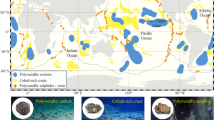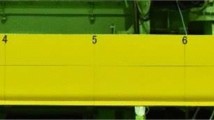Abstract
This research demonstrates the physical feasibility of constructing a single degree of freedom ocean-wave energy capturing device of extremely high efficiency, which serves also as an almost-perfect floating breakwater. The device consists of an asymmetric heaving floater and a power-take-off (PTO) system. A special geometry was first designed to have minimal effects from viscosity. As such, potential-flow analysis proved adequate for predicting the behavior of the device even in a real-fluid environment. Per ideal-fluid theory, at the heave resonance frequency, when the absorption damping of the PTO is matched with the radiation damping of the floater, an energy extraction efficiency of 96.34% can be achieved. At this high-efficiency condition, the transmitted waves beyond the floater are 12.5% of the incident-wave amplitude (or a mere 1.56% of the incident-wave energy). A working two-dimensional physical unit of 0.227m beam and 0.8m draft was designed and fabricated to work with the permanent magnet linear generator developed in (Yeung et al., 2012). The floater-PTO system was tested at The Model-Testing Facility of the University of California (UC), Berkeley. Experiments showed that when the PTO operates at even just 48% of the optimal damping, the device yields already an energy-capturing efficiency of 82%, with only 2% of the incident-wave energy transmitted. These latter values are in agreement with the theoretical predictions. Restraining lateral force and pitching moment are shown, as well as how wave energy is directed to the PTO.
Similar content being viewed by others
References
Amar, E., & Suarez, J. (2011). “Seasteading engineering report: Floating breakwaters and wave power generators”. Tech. rep., The Seasteading Institute.
Aubault, A., Cermelli, C., Lahijanian, A., Lum, A., Peiffer, A., & Roddier, D. (2012). “Windfloat contraption: From conception to reproduction”. Proc 31st ASME International Conference on Offshore Mechanics and Arctic Engineering, Rio de Janeiro, Brazil.
Bedard, R., McGinnis, D., & Klure, J. (2005). “Ocean wave energy conversion technology”. Tech. rep., Electric Power Research Institute (EPRI).
Bessho, M. (1967). “On the two-dimensional theory of the rolling motion of ships”. Memoirs Defense Academy Yokoyuka, 7, 105–125.
Brito-Melo, A., Gato, L., & Sarmento, A. (2001). “Analysis of wells turbine design parameters by numerical simulation of the OWC performance”. Ocean Engineering, 29(12), 1463–1477.
Evans, D. V. (1976). “Theory for wave power absorption by oscillating bodies”. J. Fluid Mech., 77, 1–25.
Fagley, C. P., Seidel, J. J., & Siegel, S. G. (2012). “Computational investigation of irregular wave cancellation using a cycloidal wave energy converter”. OMAE2012- 83434, Proc. 31st ASME International Conference on Ocean, Offshore and Arctic Engineering. Rio de Janeiro, Brazil.
He, F., Huang, Z., & Law, A. W.-K. (2013). “An experimental study of a floating breakwater with asymmetric pneumatic chambers for wave energy extraction”. Applied Energy, 106, 222–231.
Jiang, Y., & Yeung, R. W. (2012). “Computational modeling of rolling cams for wave-energy capture in a viscous fluid”. Paper No. OMAE2012–84153, Proc. 31st ASME International Conference on Ocean, Offshore and Arctic Engineering, Rio de Janeiro, Brazil.
Kanner, S., & Yeung, R. W. (2013). “Consideration of a rotary power take-off mechanism as a wave-energy converter on the windfloat platform”. OMAE2013–11248, Proc. 32nd ASME International Conference on Ocean, Offshore, and Arctic Engineering, Rio de Janeiro, Brazil.
Kearny, C. (2010). “The great disconnect on energy policy”. Tech. rep., World Energy Council, https://doi.org/www.worldenergy.org/documents/wec.combined.pdf.
Koutandos, E. V., & Prinos, P. (2011). “Hydrodynamic characteristics of semi-immersed breakwater with an attached porous plate”. Ocean Engineering, 38, 34–48.
Liao, S.-W. (2000). “Development and applications of the free-surface random vortex method (FSRVM)”. Ph.D. dissertation, University of California, Berkeley, CA.
Madhi, F. (2012). “Design, fabrication, and testing of a horizontal cylindrical wave-energy device of high performance”. Master’s thesis, University of California at Berkeley, Berkeley, CA.
Malara, G., & Arena, F. (2013). “Analytical modelling of an u-oscillating water column and performance in random waves”. Renewable Energy, 60, 116–126.
Mørk, G., Kabuth, A., & Pontes, M. T. (2010). “Assessing the global wave energy potential”. OMAE2010-20473. Shanghai, China: Proc. 29th ASME International Conference on Ocean, Offshore and Arctic Engineering, Estoril, Portugal.
Shugan, I. V., Hwung, H.-H., Yang, R.-Y., & Hsu, W.-Y. (2012). “Elastic plate as floating wave breaker in a beach zone”. Physics of Wave Phenomena, 20(3), 199–203.
Siegel, S. G., Fagley, C., Rømer, M., & McLaughlin, T. (2012). “Experimental investigation of irregular wave cancellation using a cycloidal wave energy converter”. OMAE2012-83388, Proc. 31st ASME International Conference on Ocean, Offshore and Arctic Engineering, Rio de Janeiro, Brazil.
Sinclair, M. E. (2011). “Design and properties of a horizontal cylindrical wave-energy extractor”. Master’s thesis, University of California at Berkeley, Berkeley, CA.
Son, D. W. & Yeung, R. W. (2014). “Performance predictions and validation of a two-coaxial cylinders system as a waveenergy extractor”. OMAE-2014-24582, San Francisco, CA: Proc. 33rd ASME International Conference on Ocean, Offshore and Arctic Engineering.
Teh, H., Venugopal, V., & Bruce, T. (2012). “Hydrodynamic characteristics of a free surface semicircular breakwater exposed to irregular waves”. J. Waterway, Port, Coastal, and Ocean Engineering, (pp. 149-163).
Tom, N., & Yeung, R. W. (2012). “Performance enhancements and validations of the UC-Berkeley ocean-wave energy extractor”. OMAE2012-83736, Proc. 31st ASME International Conference on Ocean, Offshore and Arctic Engineering, Rio de Janeiro, Brazil.
Uzaki, K., Ikehata, Y., & Matsunaga, N. (2011). “Performance of the wave energy dissipation of a floating breakwater with truss structures and the quantification of transmission coefficients”. Journal of Coastal Research, 27 (4): pp. 687–697.
Wehausen, J. V. (1971). “Motion of floating bodies”. Annual Review of Fluid Mechanics, 3, 231–268.
Wehausen, J. V., & Laitone, E. V. (1960). “Surface Waves in fluid dynamics III”. In Handbuch der Physik, vol. IX, Chap. 3, pp. 446–778, Springer Verlag. (Online: https://doi.org/www.coe.berkeley.edu/SurfaceWaves)
Yeung, R. W. (1975). “A hybrid integral-equation method for time-harmonic free surface flows”. (pp. 581-607). Gaithersburg, MD: Proc, 1st Int’l Conf. on Numerical Ship Hydrodynamics.
Yeung, R. W. (2003). “Fluid dynamics of finned bodies — from VIV to FPSO”. Vol 3, p.1–11 (Plenary Lecture). Kitakyushu, Japan: Proc.12th International Offshore and Polar Engineering Conference, ISOPE-2003.
Yeung, R.W., Peiffer, A., Tom, N., & Matlak, T. (2012). “Design, analysis, and evaluation of the UC-Berkeley wave-energy extractor”. J. Offshore Mech. Arctic. Eng., 134(2)(021902).
Yeung, R. W., Wehausen, J. V., & Webster, W. C. (1983). “Hydrodynamics of ships and ocean systems — II, lectures notes for course NAOE-241b”. Tech. rep., University of California at Berkeley.
Author information
Authors and Affiliations
Corresponding author
Additional information
US Provisional Patent No. 61/883,274 (UC No. BK-2014-037-1) URL: http://techtransfer.universityofcalifornia.edu/NCD/23530.html
Rights and permissions
About this article
Cite this article
Madhi, F., Sinclair, M.E. & Yeung, R.W. The “Berkeley Wedge”: an asymmetrical energy-capturing floating breakwater of high performance. Mar. Syst. Ocean Technol. 9, 5–16 (2014). https://doi.org/10.1007/BF03449282
Received:
Accepted:
Published:
Issue Date:
DOI: https://doi.org/10.1007/BF03449282




